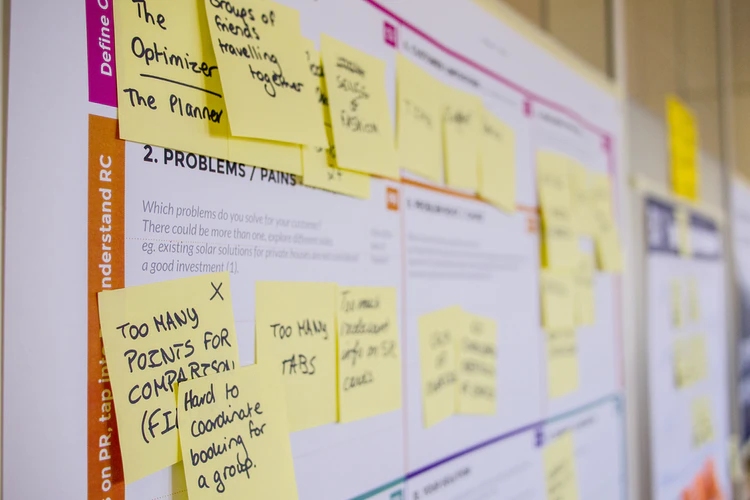Before the Coronavirus pandemic, remote work was growing at full speed.
According to the Global Workplace Analytics, telecommuting in the U.S. had a 115% increase in the past decade.
Companies started experiencing at first had the significant benefits of having distributed agile teams.
However, not every industry was prepared for this abrupt change. Very few companies had distributed agile teams. In fact, many companies’ sales departments have had a tough time shifting their regular on-site office work into a virtual one.
According to research by the Revenue Enablement Institute, the productivity of remote sales teams has dropped by 20% since the pandemic started.
Sales leaders are struggling to manage their distributed agile teams remotely. They are no longer able to gather their teams around a table, brainstorm strategies, or reunite with potential clients to sign contracts.
So, how can sales teams simulate these experiences remotely?
Currently, sales teams had to take all their tasks that required a lot of in-person interaction with an in-monitor interaction, which is not the same experience.
So, how can remote sales teams succeed during the pandemic and after it? How can they measure their results and achieve their goals? – By implementing the Agile methodology.
What is Agile?
Explaining Agile is like trying to explain why the sky is blue. The main reason is that Agile is not only a way of getting projects done but also a philosophy.
So, let’s start with the basics.
Many decades ago, software development teams struggled to deliver big and complex products to their customers. A big part of this was not the product or service itself, but the way teams used to organize themselves.
Processes consisted of putting all the plans upfront and leaving developers to make all the projects and then launch them. There’s nothing wrong with this, but the problem is that most of this hard work was soon forgotten when new apps and things came to the market.
Agile revolutionized all of this. Instead of making the whole plan and then build it, the Agile process consists of planning and developing simultaneously.
The main goal is to launch the product as early as possible.
So, for example: If a product isn’t successful, the team can make the right shifts, corrections, or even transform the product entirely – early enough instead of working on it till the end and then realizing it’s a fiasco.
This and other significant aspects came to transform the way software development teams work.
Agile was popularized by the Manifesto for Agile Software Development, which outlined their core values and principles:
- Individuals and interactions over processes and tools
- Working software over comprehensive documentation
- Customer collaboration over contract negotiation
- Responding to change over following a plan
Teams no longer needed to create an entire plan and stick up with it but they could transform and adapt.
And even though Agile was initially designed and used for software development, 15 years later of publishing its manifesto, it was recognized by Harvard Business Review and McKinsey & Company.
And nowadays, Agile has proven to be useful for all kinds of teams and organizations.
How is Agile structured?
In the first place, it’s essential to keep in mind that Agile, besides being a methodology and management style, it’s also a philosophy that encourages trust and teamwork at all times.
As a general overview, Agile projects work hand in hand with customers under a system of sprints (regular iterated cycles).
It focuses on continuous releases and incorporating customer feedback each time a sprint is released.
However, there are different types of Agile frameworks. Scrum is the most popular Agile framework, with 66% of agile frameworks being scrum or scrum variants.
“Our team has scrum-style meetings daily to discuss top priorities, roadblocks, and opportunities for collaboration,” says Matthew Speiser, a Content Marketing Manager at Knotch. “These meetings keep us all aligned and moving together in the right direction.”
One of the main characteristics of all Agile frameworks is minimizing hierarchy and building horizontal team dynamics. Yet, this doesn’t mean that the team is not structured.

For instance, in Scrum projects there are three key roles: The product owner, the scrum master, and the development team.
- The product owner: Determines what needs to be done and what are the priorities, taking into account the product backlog and the customer’s behavior. He or she has to define what is the vision of the project.
- The scrum master: Controls the process and sets the due dates. Their main responsibility is to clear the roadblocks and move towards the vision provided by the product owner.
- The development team: All the other team members that work together and determine what are the best approaches for achieving the objectives. The team ideally should be cross-functional.
Having these roles cleared up, teams can start developing their projects. Scrum teams work in a series of iterations also known as sprints, as stated previously.
Sprints consist of a time-boxed period in which a Scrum team organizes and works in order to accomplish the objectives of that sprint. Each sprint has:
- Sprint planning: A team meeting where all members plan and decide how the sprint is going to be completed.
- Daily stand-ups: Short (15 min) daily meetings where each member of the team shares in what tasks they worked the day before, their plans for the current day, and if they are having any difficulty.
- Sprint demo: It’s a sprint review where the finished product backlog items are shown. All the team members demonstrate with informal presentations what they’ve done to reach the sprint’s goals.
- Sprint retrospective: A final review of what worked and what didn’t to improve the upcoming sprints.
This is a general overview of how Agile (and Scrum, specifically) teams are structured.
Most Agile framework’s success relies on the fact that having a structured process that is adaptable through time encourages teamwork and manages efficiently due dates (among other vital aspects.)
How can Agile help sales teams?
Agile was originally designed for software teams with a specific product to build and deliver in a determined time frame. Yet, its structure and principles have transformed entirely the way many industries and companies work.
The sales teams are one of the most affected when it comes to remote work.
One of the keys to succeed in a digital environment is not trying to simulate the same experience teams had before the pandemic or before remote work.
The key is to completely transform and adapt to the digital era we are currently living in. And to embrace remote work, teams should get rid of the old sales models and implement new models and strategies.
Luckily, distributed Agile teams have proven not only to adapt but to succeed in the process. And the same model used by thousands of companies and industries is now starting to gain terrain in the sales teams.
The ‘’magic’’ of distributed Agile teams is that they know that process matters; that’s why there are determined roles and steps to follow.
But beyond that, all agile teams and coaches are successful because behind those processes; there is also a mindset of leading a team.

Distributed Agile sales teams know the importance of building trust among their team. This starts in the first place by truly understanding the meaning of self-management.
Agile leaders don’t need to continually breathe over their employees’ shoulders or ask them about their work.
99.9% of the time, projects fail because managers don’t trust their teams. They feel this need to micromanage every step of the process.
Agile encourages managers to ditch micromanage and adopt self-management among all employees.
Employees know that they have to accomplish specific responsibilities, that they have to work under due dates, and most importantly: if they don’t do their part, the project won’t work. They are self-reliant because their manager trusts them.
Another crucial characteristic that highlights why agile is necessary for remote sales teams is time.
Distributed teams evaluate their work on results, and results to happen need to be established under a limit of time.
Yet, time goes hand in hand with adaptability – when sales teams faced the fact they weren’t going to be working with their coworkers anymore, but they had to work from home, the change was drastic. How was this going to be possible?
Agile encourages leaders and teams to adapt to these changes. This means that leaders should be seeking alternatives for building efficient distributed sales teams. And also, different strategies to achieve their goals virtually. For example, to create a plan to gain more leads digitally. Or figure out the best ways to promote a product through social media.
Agile can help sales teams that are currently facing remote work by helping both leaders and teams adopt a mindset open to changes, trust, accountability, and organization.
Strategies to implement Agile in your sales team
1. Establish short and long term goals
Think about your current situation. How are the numbers looking? Analyze where you are standing, and with what you have, where do you want to go?
Organization is a vital element when establishing your goals. Because even though you are tracing a path to the ‘’final’’ destination, you need to think in the short-term goals that will enable you to achieve the bigger ones.
Establishing goals also means having to transform and deeply analyze the structure you were using before shifting to a remote one. As you might have experienced, the strategies you use to implement in your on-site sales team are not as efficient on remote teams.
You are now seeking different results and managing a distributed sales team. So, reevaluate your structure, transform it, and set a clear vision of where you want to go.
2. Flexibility matters
Yes, I know. I probably repeated flexibility and adaptation many times now, but it’s because when managing a distributed agile sales team, you need to be prepared to adapt when it’s necessary.
Besides defining your strategic sales processes and main goals, it also helps to encourage your team to experiment new ideas. To get creative and think outside the box when it comes to achieving those goals.
3. Establish strong communication channels

Managing remote teams is all about communication. All teams, no matter the industry, need to communicate. And when it comes to managing a remote team, things get a bit harder at the beginning.
So, start with the basics. Create a communication guideline for your team, where you explain clearly how communication will work.
This means to find out what communication tools work best for your team and determine how to use them.
For example, let’s imagine you use 3 communication tools: Slack, Skype, and Gmail. Whenever you have meetings, which tool will you be using for meetings? For reminders? For documentation? For short-informal meetings? All of this needs to be clear in the guidelines.
4. Daily meetings and feedback meetings
Daily standups are fundamental in Agile. It’s the best way for you to know what each member of the team is up to, how the project is evolving, and if someone is stuck with something.
Although initially, daily standups consisted of literally gathering in a small room for 15 minutes while standing up and discussing these things, virtually, it’s also possible. You could schedule a daily Zoom meeting, for example.
Besides daily standups that are mainly about work, it’s equally essential to arrange feedback meetings individually with the team members.
Tell them how you feel they are performing, congratulate them if it’s the case, and if not, this space is a good way to help them improve in aspects they might be struggling with.
Also, as managers, we need to seek our employees well being. Feedback meetings are also the space in which we can ask them how they feel and if everything is okay.

5. Motivation
Celebrating wins is an innovative way to motivate distributed teams. You can’t go to drink beers, but you can organize a happy hour or a virtual party to celebrate that your team achieved a determined goal.
Also, besides giving feedback, you can motivate your distributed agile sales team by creating a reward system. When you are working with a distributed sales team, you can easily measure how well your team is doing, and if an employee achieved a certain sales target, for example.
Also, motivation besides the rewards is lifting your team’s spirit when things aren’t going well. These times are hard; many people have to stay home with their families working with noise, and having a boss that yells at them will only make things worse.
But having a leader who encourages them to improve continuously and be their better version will have great results in less time than you think. Motivation in remote employees means everything for them.
6. Provide continues coaching and sales training
Sales teams will never be the same. The whole structure that teams used to know is changing. So teams need to be on top of their game to succeed.
By providing continued coaching, your team members will continue their learning process, which helps them even think in new ways and approaches to reach the vision established initially.
Nowadays, they’re thousands of courses online with digital sales strategies, and talking about the digital language, or selling in a virtual environment, that your team could highly benefit from.
As Benjamin Franklin said: “An investment in knowledge pays the best interest.”
Ready to build your distributed Agile sales team?
Sales teams face two options: Trying to survive with what they know and the structure they have, or adapting to the change and succeed.
Building a distributed agile sales team is not only about going by the book and mimicking everything agile teams do. More than that is about understanding their core values and the importance of teamwork and trust.
Agile can help your team to work efficiently remotely. And even though it’s not a magical solution that makes you earn 1 million dollars a day, it still helps you to structure and organize your team.
Of course, a vital part of this is hiring the right people to help you achieve the goals and reach your team’s vision.
About the Author:

Sharon Koifman is an expert in remote work. He is the founder and CEO of DistantJob, a unique recruitment agency who specializes in the recruitment of the best full-time remote workers around the world.


